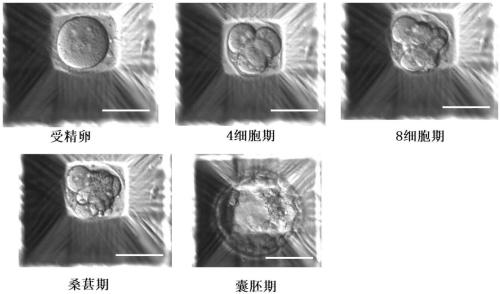Culture method for development of waste embryo blastocysts
A technology for embryos and blastocysts, which is applied in the intersecting field of microfluidic technology and reproductive biology, can solve the problems of small number of ICM cells, difficulty in establishing lines, etc., and achieve the effect of improving the development rate of blastocysts
- Summary
- Abstract
- Description
- Claims
- Application Information
AI Technical Summary
Problems solved by technology
Method used
Image
Examples
Embodiment 1
[0042] Preparation of Pluronic F-127 Modified Microfluidic Chip
[0043] 1) Soak the microfluidic chip in absolute ethanol for 15-40min, rinse with deionized water, dry in vacuum, and set aside;
[0044] 2) Put the cleaned microfluidic chip into the plasma generator, evacuate to 0-1Pa, introduce oxygen to 10-200Pa, adjust the discharge power at 5-300W, and perform radio frequency discharge for 0.5-10min;
[0045] 3) Apply a certain volume of Pluronic F-127 solution with a protein concentration of 0.2-2% on the surface of the chip in a vacuum state, and incubate for 2-6 hours (37°C) or 12-24 hours (4°C);
[0046] 4) Discard the chip surface solution in step (3), rinse 3 times with sterile deionized water, dry, and package.
Embodiment 2
[0048] Effect of Pluronic F-127 Modified Microfluidic Chip on Embryo Development
[0049] The microfluidic chip prepared in Example 1 and the microfluidic chip not modified by Pluronic F-127 were respectively soaked in 75% ethanol, placed in a vacuum incubator to vacuumize for 10 minutes, and then the embryo suspension was quickly mixed with 1×10 3 The density of embryos / mL is added to the surface of the chip, and a single embryo is introduced into a single trap by using negative pressure and gravity; when the embryo settles to the bottom of the trap, cover it with fresh medium and mineral oil to prevent evaporation; The medium is replaced every two days to supplement the embryos with nutrients and discharge metabolic waste.
[0050] The microfluidic chip modified by Pluronic F-127 above and the microfluidic chip of the control group unmodified by Pluronic F-127 were counted from the inoculation of embryos to start culturing, and the embryonic development including cleavage ra...
PUM
| Property | Measurement | Unit |
|---|---|---|
| length | aaaaa | aaaaa |
Abstract
Description
Claims
Application Information
 Login to View More
Login to View More - R&D
- Intellectual Property
- Life Sciences
- Materials
- Tech Scout
- Unparalleled Data Quality
- Higher Quality Content
- 60% Fewer Hallucinations
Browse by: Latest US Patents, China's latest patents, Technical Efficacy Thesaurus, Application Domain, Technology Topic, Popular Technical Reports.
© 2025 PatSnap. All rights reserved.Legal|Privacy policy|Modern Slavery Act Transparency Statement|Sitemap|About US| Contact US: help@patsnap.com



